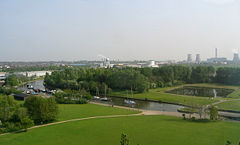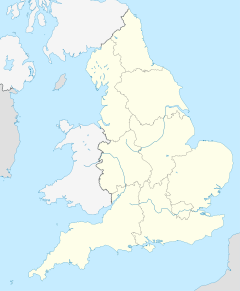Widnes
| Widnes | ||
|---|---|---|
| Spike Island | ||
| Coordinates | 53 ° 22 ′ N , 2 ° 44 ′ W | |
| OS National Grid | SJ5185 | |
|
|
||
| Residents | 63,830 | |
| administration | ||
| Post town | WIDNES | |
| ZIP code section | WA8 | |
| prefix | 0151 | |
| Part of the country | England | |
| region | North West England | |
| Ceremonial county | Cheshire | |
| Unitary authority | Borough of Halton | |
| British Parliament | Halton | |
Widnes is a town in Halton Unitary Authority in north west England . It is located on the north bank of the River Mersey , across from Runcorn and has a population of 63,829 (2018).
Name and story
The origin of the name Widnes is not fully understood. In part, it is believed that it goes back to the Danes , who called the settlement vidnes (wide nose). This could refer to a promontory in the Mersey that creates a narrowing in the river called the Runcorn Gap . Another opinion is that it is a Norwegian name as there is a comparable peninsula called Vidnes in the Møre and Romsdal districts of Norway.
Widnes has always been an industrial city, the chemical industry in particular dominates the city and has led to a real population explosion: While Widnes was little more than a village around 1800, it already had 50,000 inhabitants in 1900. The history of the chemical industry in Widnes can be seen in the specially created Catalyst Museum. Today Bayer CropScience operates a factory in the town.
Worth seeing
Widnes is connected to Runcorn by the Silver Jubilee Bridge , a road bridge built in 1961. Previously there was the Runcorn Railway Bridge , a railway and pedestrian bridge that was built in 1868 and still stands today. The Runcorn transporter bridge between Widnes and Runcorn, built in 1905, was the largest of its kind in the world in its time. It was demolished after the Silver Jubilee Bridge was completed. In front of the bridge there was a ferry that first sailed in 1178. The Mersey Gateway Bridge has been part of a bypass road that avoids the town centers since 2017 .
On the western outskirts of Widnes is the village of Hale; in the cemetery is the grave of John Middleton (1578–1623), who was said to be 2.82 m, in fact probably 2.36 m tall. In Farnworth , in the north of the city, is the 11th century church of St. Luke. To the northeast is Pex Hill , where the Liverpool Astronomical Society maintains an observatory .
While waiting at Widnes North Railway Station , it is said that Paul Simon was inspired to write the song Homeward Bound . Widnes is known for its rugby club, the Widnes Vikings .
Personalities
- Paul Sherwen (1956–2018), cycling commentator and cyclist
- Michael Kenna (* 1953), landscape photographer
- Charles Glover Barkla (1877–1944), physicist (Nobel Prize 1917)

